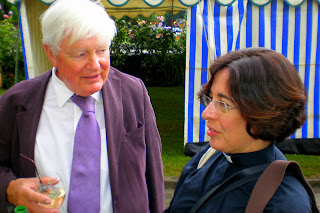
With a certain reluctance, I said farewell to Morley College earlier this month as 'Inside the BBC Symphony Orchestra' moves to my other adult education base, the City Lit, in September. There was much about Morley that I liked, and the new brooms certainly seem more efficient, but over the decade I served there, the sound equipment was never right for more than a week or so.
It was always worth the pittance to think that one was following in the footsteps of Holst and Tippett (that very human artist Maggi Hambling, incidentally, still teaches there). Imagine my astonishment when I took out scores of Holst's The Planets and Choral Hymns from the Rig Veda, and discovered GVH's signature in both. I told the library to put them into their special collections immediately, which (eventually) they did. One of the people I shall really miss at Morley, head librarian Elaine Andrews, has been helping me to look at other papers they have, including a handwritten essay on Holst by Vaughan Williams. On Friday I duly took photographs of some of the more valuable documents. Above are the Choral Hymns, and below a first edition of The Planets which I imagine is a little more valuable for the addition of the great man's signature.

After the valedictory visit, it was only a very short bike ride via Evans' Cycles to the Young Vic, which I was seeing for the first time inside since its revamp. It's now an ace bar with a theatre attached, and I don't suppose the youth drinking there have much to do with the stage. Can the punters get a drink in the interval now? Not on a Friday night, at any rate.
But that wasn't the reason for going, which was to see one of America's greatest pieces of music theatre - possibly THE greatest between Porgy and Bess and Sweeney Todd, Kurt Weill's Street Scene. Like The Pilgrim's Progress the other week, but for a completely different reason, this was another trip down memory lane as it's nearly 20 years since I attended the Decca sessions for the work in Glasgow. That was when John Mauceri resuscitated Street Scene's then rather faded fortunes, and by the time David Pountney's production, orginally for Scottish Opera, came round at ENO for the second run, even those who'd scratched their heads about this curious hybrid were ready to declare it a masterpiece.
Remembering Glasgow 1989 was also a time to mourn again for Jerry Hadley, such a nice guy and a deeply expressive tenor at his best, as in Street Scene's 'Lonely House', The Rake's Progress and a disc of Britten song cycles for which I have a special fondness. Arleen Auger, co-cameo nursemaid with Della Jones, is also no longer with us: and what a delightful, funny person she was, too. I'm so glad I met her then.
This latest staging, in which John Fulljames directs a group of singers most of whom I'd never even heard of before and Patrick Bailey conducts a more than respectable orchestra, together comprising what is called The Opera Group, had an almost unbearable intensity in the small space of the Young Vic. Again it drove home how Weill's and Langston Hughes's adaptation of Elmer Rice's hard-hitting play about New York tenement life interlaces sassy numbers extolling hard-working immigrants' American dream with darker operatics undercutting those characters' hopes, if not entirely negating them. Elena Ferrari invested so much energy and focus in the central role of Anna Maurrant, the housewife whose life has become so meaningless, and vitally, too, the lyric soprano playing her nice, sensible daughter Rose, Ruby Hughes, carried on the torch after Anna's murder. Where else in opera, it was asked in the programme, does the action carry on for a scene following the death of the heroine? I could think of only one other example, The Cunning Little Vixen by the equally offbeat Janacek, but that's about the continuation of the natural order, while Street Scene offers no such consolation. Here are Ferrari and Hughes together, as photographed for The Opera Group by Alistair Muir:

Most of the not-so-bit parts were strongly taken, too (and always have been: I well remember Catherine Zeta-Jones in 'Moon faced, starry eyed' at the Coli, and found in the same programme a credit for the student Rosemary Joshua as 'first graduate' in the tearjerking scene when the daughter of a dispossessed family comes home with her school diploma 'Wrapped in a ribbon and tied in a bow'). Who knows how many of these ones will go on to greater things? The kids, especially, were terrific, and there was a huge chorus as well as a full orchestra with the strings on the ground floor, wind and brass coming across beautifully clear in Weill's often romantic orchestration from the first. Three cheers for his ever-relevant humanity.


































